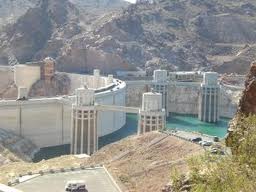
1. Abstract
Tajikistan’s Rogun Dam is the definition of a work in progress. Construction of the
colossal structure began in 1976, yet the work remains unfinished today. Across Central Asia,
corruption and a lack of funds have incessantly hindered state governments’ efficacy since the
collapse of the USSR. That being said, Tajik officials are bringing new meaning to Central Asian
futility. Yet the state’s inefficiency is still not the greatest impediment to the success of Rogun
Dam. By building this dam, the Tajik government would essentially be robbing neighboring
Uzbekistan of highly valued water resources. The dam is being constructed on the Vakhsh River,
which cuts directly through Tajikistan before spilling into adjacent states. Without the reliability
of the Vakhsh, Uzbekistan’s agriculturally focused economy will suffer. Thanks in large part to
climate change; Central Asia is hemorrhaging resources at a time when these states should be
rebuilding in their antebellum years. To understand this potential conflict more fully, it is helpful
to look at a more holistic version of the dam’s history.
2. Description
Tajik authorities first proposed the blueprint of Rogun Dam over fifty years ago, with the intent of increasing the then-Soviet Republic’s energy independence. During the Soviet Union’s
disintegration, however, construction halted. Even though Rogun Dam, upon completion, is
scheduled to be the world’s tallest, Tajik workers were not capable of even coming close to
finishing the project in its first fifteen years. After declaring its independence and suffering
through a bloody civil war, the country was in no hurry to restart the costly dam construction. As
the poorest of the former Soviet Republics, Tajikistan was forced to look abroad for help with
the dam. In this effort to find a party to bankroll Rogun, the Tajik government launched an initial
public offering, with hopes of raising around $1.5 billion. By 2010 Tajikistan has raised enough
funds to begin finishing Rogun. The amount of money raised at the start of construction in 2010
was only enough to keep the project going for another two years. Finally, Tajik officials
managed to garner enough financial support from the World Bank and the Russian aluminum
company, RUSAL, to ensure the project’s continuation.
Rogun Dam’s biggest challenge does not coming from funding though, it comes from
Uzbekistan. Tajik authorities have claimed that Uzbekistan is simply trying to hinder the
progress of a neighbor. This is not entirely true, however. Granted Uzbekistan prides itself on the
country’s relative economic success and is not looking for regional competition. Yet cutting off
access to the Vakhsh River will have a very real negative impact on Uzbek agricultural output. As the world’s sixth largest producer of cotton (a nearly ubiquitous commodity at this point in history), Uzbekistan cannot simply not afford to lose that vital irrigation water. Such a loss would be a massive blow to the entire Uzbek economy, not to mention the economy of greater Central Asia. Uzbek cotton drives the country’s export economy and with the world’s tallest dam just
upstream, there is no way Uzbekistan could avoid water shortages. The problem is so close to the
forefront of the national consciousness that in late 2010 Uzbek President Islam Karimov went to
the World Bank for assistance. Karimov negotiated with the World Bank until they agreed to
launch an investigation into the project. The case is ongoing and focuses on the social and
environmental impacts of such a dam clogging up this vital river.
The Vakhsh is indeed vital, and not just to the Uzbeks. Tajikistan gives its citizens very
few reasons to feel proud. An overabundance of water, however, is one thing with which most
Tajiks satisfied. Massive, elegant fountains line the streets of the capital in Dushanbe. Families
know not to worry about wasting water and thus faucets are often left running for much longer
than necessary. So one can begin to see how the locals view the Rogun Dam project. They see it
as another source of pride that further exploits the country’s good fortune. Of course this attitude
is reckless and close-minded, but Tajiks have little else around which they can rally.
Besides merely placating Tajik citizens, the dam would have other potentially positive
outcomes. Tajikistan’s CASA100 program, for example, would transfer Tajik electricity and
irrigated water to Pakistan via Afghanistan (Mashrab). Tajik President Emomali Rahmon
supports this program, but only sees it succeeding along side a completed Rogun Dam.
believes CASA100 could help decrease the number of opium farms. With easier access to
electricity and water, Afghan farmers would probably switch to less controversial cash crops,
Rahmon believes (Mashrab). Whether CASA100 would actually realize its full potential is yet to
be seen. It appears to hold true, however, that the project will be infinitely more successful with
greater electrical output and control of irrigated water from the Tajik side. At the very least,
Tajik-Afghan relations are strong enough that cooperation may stand a fighting chance.
Cooperating with the Uzbeks, however, will be much more difficult. Tensions between
these two former Soviet Republics go back a while. These states have long tried to outcompete
one another. Whether it is gas exports, or access to water, or who can build the world’s tallest
flagpole (located in Dushanbe, Tajikistan – 541 ft.), Tajikistan and Uzbekistan are consummate
rivals. This perennial friction has gone on long enough that analysts agree the two countries are“engaged in an undeclared cold war” (Stern). As far as potential for real conflict goes, it is difficult to forecast. At the start of almost every new year, organizations release reports on the potential wars in the coming year. Tajikistan and Uzbekistan are veterans to such lists. Analysts seem to think the tension could come to a head at any point. The entire region is filled with volatile, mercurial despots, who interact with their rival neighbors only begrudgingly. One tactless press release or official statement could send the region into chaos, and thus it is hard to find concrete data on what could happen in Central Asia. For this reason, not many officials have taken note
of this new ardent bickering, which has the potential to evolve into a violent conflict.
Perhaps the most noteworthy lesson from this situation is that tempers could have
remained cool, if not for global warming. With average temperatures on the rise worldwide, Tajikistan has been melting.
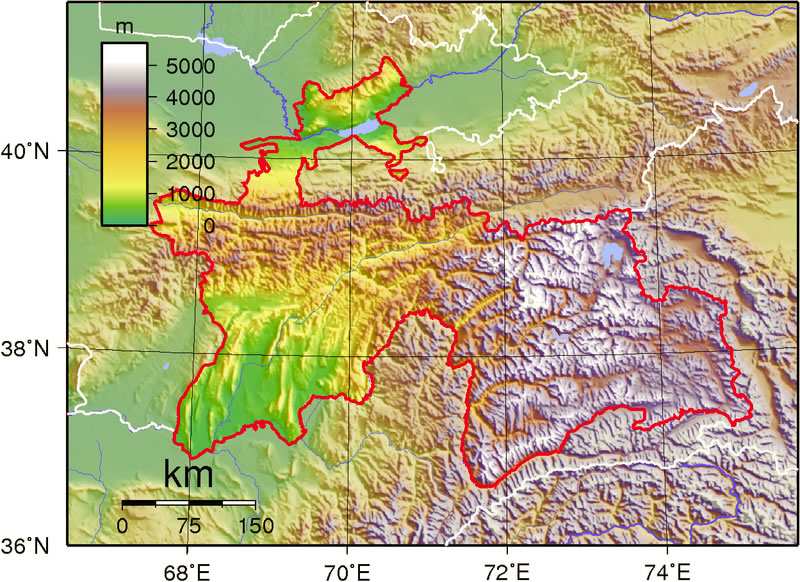
Tajik Topography (Figure 1)
As illustrated by Figure 1 above, the country is 93% covered in
mountains (The World Factbook). The Pamir Mountains completely carpet the eastern half of
Tajikistan. The range, known as the ‘roof of the world,’ tops out around 25,000 feet above sea
level (The World Factbook). Over the past few years, while the glacial snow has melted at a
greater volume, the level of the Vakhsh River has grown. Floods and landslides have become
more frequent occurrences in recent years. Tajikistan’s average temperature, alone, has increased
by about 1.2 degrees Celsius since 1940 (Swarup). Because experts believe that 30% of
Tajikistan’s glaciers may disappear by 2050, it is clear to see why Tajik authorities suddenly
restarted construction on the Rogun Dam in 2010 (Swarup).
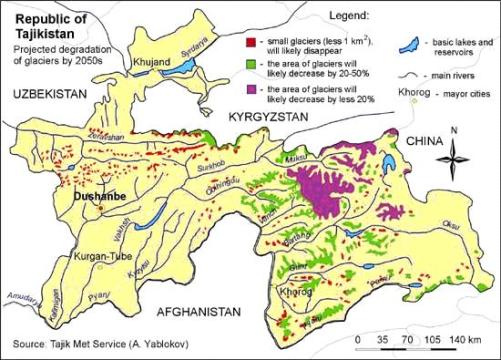
Projected Topography (Figure 2)
Figure 2 shows that this mass melting of glaciers is an escalating problem within Tajikistan and
around the region. Such a huge loss of natural resources will have a profound effect on
Tajikistan, if the country fails to find ways to secure its future. It is evident that in the next
century, Tajikistan will not be able to so easily capitalize on its own water reserves. This
sobering realization must have helped spur President Rahmon to action.
With any luck, Rahmon’s decisions will not lead to a chaotic chain of events. In Central
Asia though, Murphy’s Law is usually the only one to hold true. Since 1976, Rogun Dam has
been a major issue in regional relations. Regardless of the overt impact the dam will have on the
Uzbek economy, Tajik officials see Rogun as a looming necessity. Not only do Tajiks see the
dam construction as a right, but they also believe it could help spread peace. Rahmon’s
CASA100 program is scheduled to increase cooperation with Afghan farmers. The Tajik
authorities hope CASA100 will decrease the amount of opium grown in Afghanistan and
smuggled through Tajikistan. Rarely has Tajikistan been able to find common ground with its
neighbors, so the fact that Tajiks can work with Afghans is a step in the right direction. The
relationship with Uzbekistan, however, is deteriorating. The two have never seen eye to eye, but
completion of Rogun might finally help this conflict realize its violent potential. It is important to
remember that this problem could have been avoided. Through global warming and subsequent
rising river levels, Tajikistan sees more and more benefits to finishing the Rogun Dam. This dam
could literally save lives by reducing the number of fatally hazardous floods and mudslides. The
Tajik glaciers are melting and will most likely never return. This frightening truth means it is
time for Tajiks to take advantage of their resources while they have them. The future of water
availability in Tajikistan is in jeopardy, but Rogun Dam, despite its negative externalities, will
bring a modicum of stability to this truly troubled country.
3. Duration
Preliminary:
Project proposed in 1959
Construction:
Began in 1976; halted in 1991
Restarted in 2008; funding continuing through 2013
4. Location
Continent: Asia
Region: Central
Country: Tajikistan
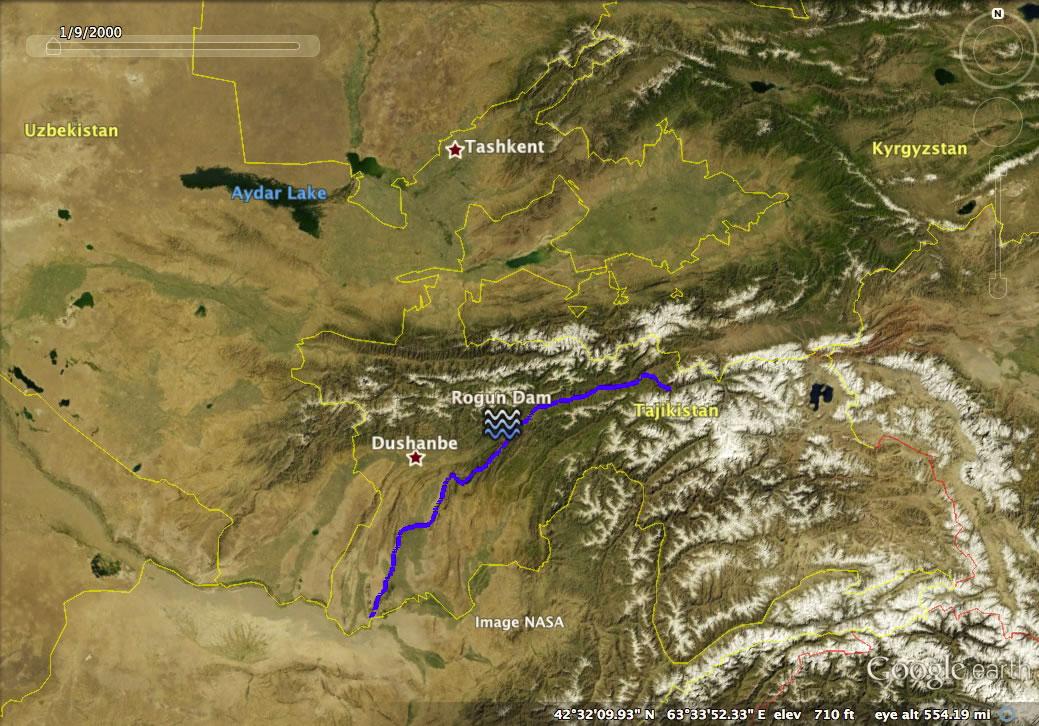
Tajikistan (with Rogun Dam and Vakhsh River highlighted)
5. Actors
Sovereign Actors: Tajikistan, Uzbekistan
Non-Sovereign Actors: World Bank (funding)



6. Type of Environmental Problem
(e) Climate Change: Given the constantly changing global climate, Tajikistan's otherwise mountainous and semi-arid ecosystem will eventually become completely arid with few remaining glaciers to bring water to the area.
(i) Many Factors: Rogun Dam will help Tajik officials conserve their water resources well into the future, but it will kill Uzbekisan's agricultural economy in the south by cutting off access to water used for irrigation.
7. Type of Habitat
(c) Dry: Though it is usely considered the least arid country in the region, Tajikistan is still quite dry, with most of its water resources tied up in the highly elevated areas to the west.
8. Act and Harm Sites:
(a) Conflict Harm Location: Tajikistan's southwest border with Uzbekistan
(b) Act Site: Rogun Dam is located in West Central Tajikistan. This potential conflict will originate from that point.



9. Type of Conflict
(a) International: This quarrel could soon turn violent, and would thus embroil one of the world's poorest regions in a bitter conflict that would lack a definitive endgame.
10. Level of Conflict
(a) Resource Access: Without the availability of fresh water flowing across the border to Uzbekistan, the country's population will suffer economically and in regards to its overall sanitation and health.
(b) Natural Environmental Changes: It is these very environmental changes that have spurred Tajiksitan's government to reactivate the construction efforts at Rogun.
11. Fatality Level of Dispute (military and civilian fatalities)
(c) Low: Thus far, Tajikistan and Uzbekistan's long-standing rivalry has remained cold. There have been no deaths that were a direct result of this potential conflict. Tensions, however, are on the rise and have been escalating exponentially over the past couple years. Few experts are willing to project what an all-out war would look like between these two countries. Given each state's lack military capability though, any conflict would certainly require a great deal of human sacrifice.



12. Environment-Conflict Link and Dynamics:
Causal Diagram
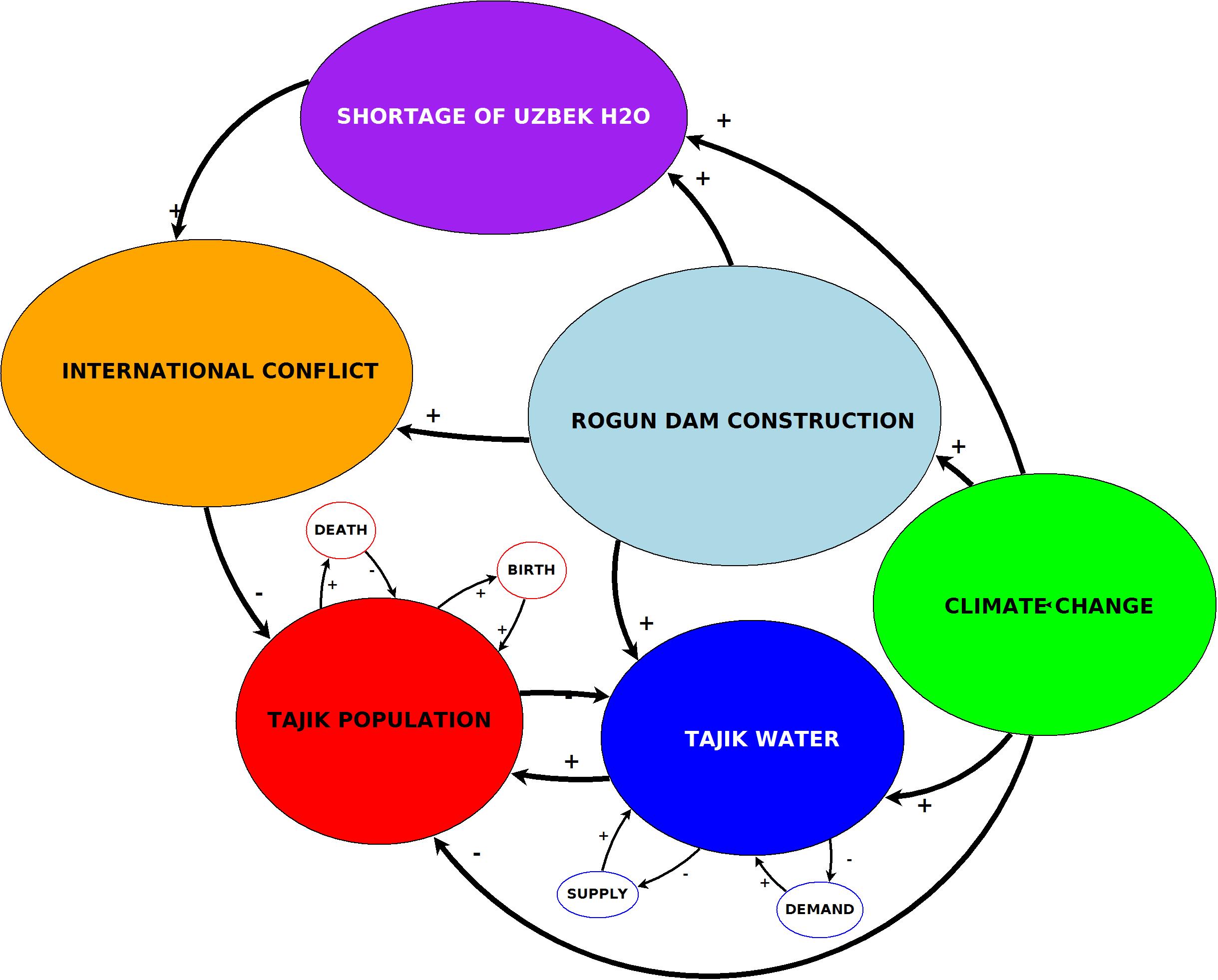
Causal Diagram Relating Dam Construction and Climate Change to International Conflict
The following diagram illustrates the variables and potential outcomes associated with
the Rogun Dam project in Tajikistan. The relationship between these variables is multifaceted,
with various possible end results. Between the Tajik population and the amount of Tajik water at
any given point there is a direct relationship. This is fairly self-explanatory, as water is the
underlying source of life on our planet.
Moving beyond these two base variables, there are essentially two other factors that are
introducing themselves into the status quo. Climate change is the first of those. Both Tajik
population and Tajik water are directly correlated to climate change. As the world warms, glacial
ice in the Tajik mountains will be converted to water and liberated from its previously
untouchable peaks. The release of this fresh glacial water will be above average at first, and then dissipate as the planet warms, but the water supply decreases. The initial increase in water supply will ultimately increase Tajik population size,
as communities become more prosperous.
The second foreign factor is the construction of Rogun Dam. This dam, if completed, will
bring Tajik-Uzbek relations to a boiling point. The dam-construction variable is directly related
to the following: the amount of Tajik water, a lack of Uzbek water, and to international conflict.
By building the dam, Tajik authorities would certainly secure even more water resources (not to
mention energy independence) for its own people. Such a move, however, would severely limit
neighboring Uzbekistan’s water supply and therefore increase international conflict. So while a
shortage of Uzbek water and the potential for international conflict are represented in this diagram as
auxiliary variables, both could quickly become the focal point of any discussion on Rogun Dam.
13. Level of Strategic Interest
(d) Region: As one can imagine, a conflict between these two states would have immediate negative effects on the entire region. Central Asia, as an area full of nascent independent states, is incredibly volatile. Politics here is fueled by rivalries and brinksmanship. Authoritarian rulers there tend to send threats first and consider negotiations later.
14. Outcome of Dispute:
(b) In Progress: As previously stated above, experts agree that Tajikistan and Uzbekistan have been involved in an unofficial cold war for a very long time now. The majority of scholars view the Rogun Dam quarrel as either another minor scuffle, or a serious concrete conflict that will escalate tensions to a dangerous level.



15. Related ICE and TED Cases
MEKONG Mekong Dam in Laos and Environmental Impacts (Cross link to TED case 258), by Paul F. Macek (January 1996)
ATATURK Turkey, Ataturk Dam and Downstream Disputes, by Nathan Martz (TED Cross-list #186)
NARMADA The Narmada Dam and Ethnic Conflict in India, by Talib Ellison
URRA Urra Dam in Colombia, by Regina Kreger
BAGLIHAR Baglihar Dam, by Usman Ahmad
KOREA-DAM North Korean Dam and Security Aspects, by Sgt. Sungwoon Kang
KURD-WATER, Turkey, Dams, Kurds and Conflict Within and Between Countries, by Navid Ahdieh
AMAZON-DAMS, Amazon Battle: Dams Conflicts, by Olimar E. Maisonet Guzman
CHINA-DAM-IMPACT, Breaking Ground: Environmental and Social Issues of the Three Gorges Dam in China, by Blake Campbell-Hyde
BELOMONTE, Belomonte Dam in Brazil and National Climate Policy, by Elizabeth Snider
16. Relevant Websites and Literature
Marat, Erica. “Will Tajikistan Successfully Construct Rogun?” The Jamestown Foundation. 01-
26-2010. Retrieved 02-13-2013.
Mashrab, Fozil. “The Rogun Juggernaut.” Asia Times. 01-04-2012. Retrieved 02-13-2013.
Stern, David. “Tajikistan Hopes Water Will Power Its Ambitions.” The New York Times. 08-31-
2008. Retrieved 02-13-2013.
Swarup, Anita. “Reaching Tipping Point?: Climate change and poverty in Tajikistan.” Oxfam.
02-17-2010. Retrieved 02-13-2013.
The World Factbook. Central Intelligence Agency. Updated 02-05-2013. Retrieved 02-13-2013.
Wegerich, Kai. “Reliving the past in a changed environment: Hydropower ambitions,
opportunities and constraints in Tajikistan.” Elsevier. 03-13-2007. Retrieved 02-13-2013.



[Joseph Chmielewski, updated 4/24/2013]






